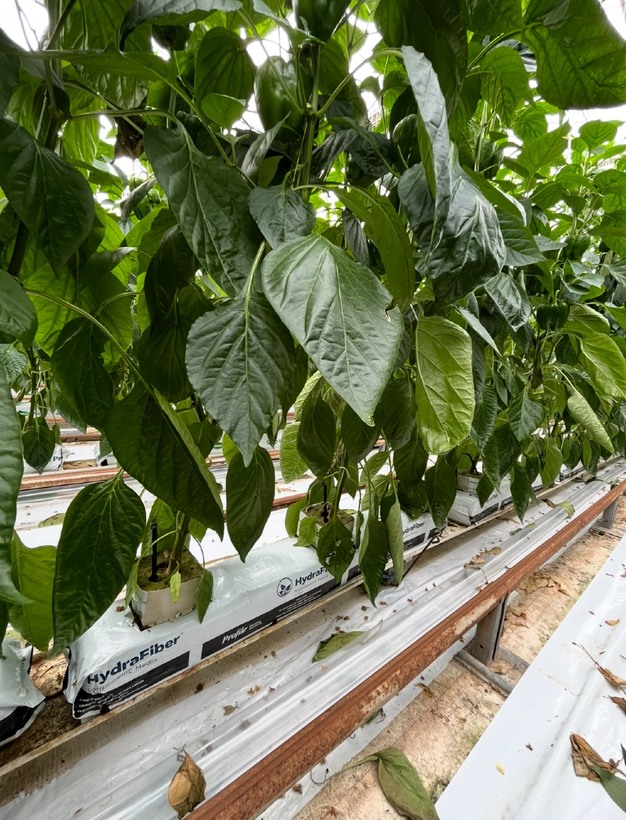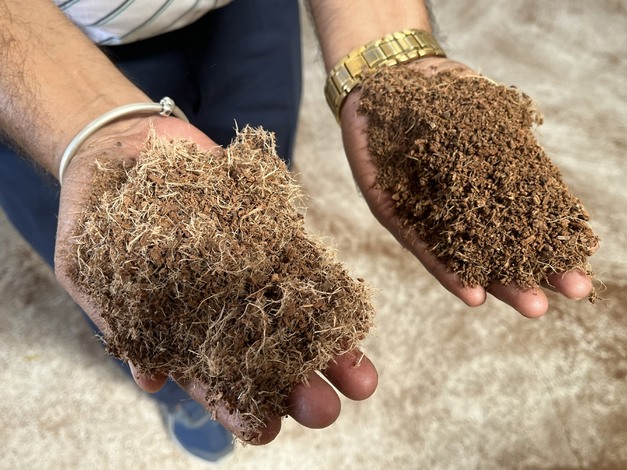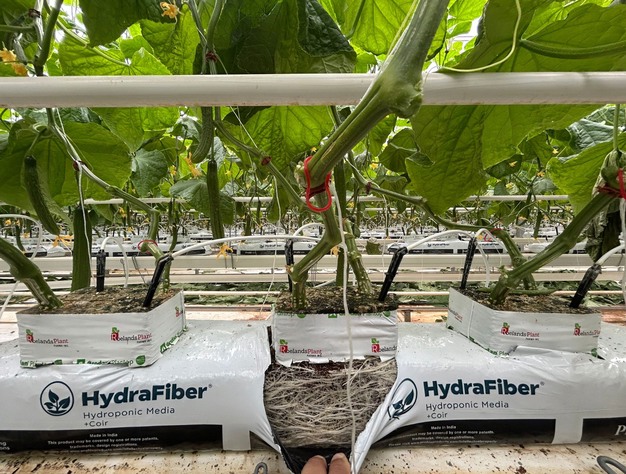The search for alternatives to inorganic substrates has led to new applications of organic fibers in recent years. One relatively new product for soft fruits and vegetables was introduced by Profile Products: the HydraFiber Coir slabs, a blend of their patented wood fiber with coir. Since Ferdi van Elswijk is passionate about making horticulture more sustainable, he took on the role of Global Head of Hydroponics at this company last year. "The timing is right, the market is right, and the product is right. It's a more sustainable substrate and enables growers to grow more sustainably in many other ways as well: in terms of water usage, biological control, and plant health."
New product category © Profile Growing Solutions"HydraFiber represents a separate product category within substrates," Ferdi explains. "Our HydraFiber is more than just coir—it's a new substrate category, but a distinctive substrate. That gives us something truly different, and we see it perform differently in practice, both in terms of root development and plant growth."
© Profile Growing Solutions"HydraFiber represents a separate product category within substrates," Ferdi explains. "Our HydraFiber is more than just coir—it's a new substrate category, but a distinctive substrate. That gives us something truly different, and we see it perform differently in practice, both in terms of root development and plant growth."
That requires a bit of technical background. Profile Products originated in erosion control and hydroseeding mulches. Since 1997, Profile has been producing various wood fiber materials for use to prevent erosion of mountain slopes, construction sites, and riverbed embankments. The company has refined its fiber technology through heat, pressure, and a drying process to soften and loosen the fibers, which are then further treated mechanically. The material is then dried and refined to make it less susceptible to bacteria. The final step is compression, so it can be shipped compactly.
HydraFiber, introduced about a decade ago, is an engineered fiber made from 100% renewable wood sources. Usage in horticulture began when blenders started using these fibers as a replacement for perlite. The use of wood fiber allows for more airspace for better rooting, easier water uptake, and a drier surface to reduce algae and fungus gnats—using a recyclable product.
In recent years, Profile Products has also been supplying these products as slabs for horticultural applications. "Profile's R&D team figured out a way to mix very fine coir with wood fibers and turn them into a hydroponic growing slab." The final product consists of 60% coir and 40% wood fiber. This combination is patented and has proven useful for many crops like vegetables and soft fruits.
 © Profile Growing SolutionsThe difference between HydraFiber+Coir (left) and coir (right)
© Profile Growing SolutionsThe difference between HydraFiber+Coir (left) and coir (right)
 © Profile Growing SolutionsManufacturing location
© Profile Growing SolutionsManufacturing location
Cultivation results
The HydraFiber Coir slab has already gained a strong foothold in the North American home market. In the Netherlands, twelve innovative companies started using HydraFiber this year. "Growers are seeing a different root structure," says Ferdi. "The mix of coir and wood fiber provides greater available oxygen in the root zone. Porosity is increased, while water retention is maintained. This combination results in enormous root hair branching. Previously, roots from the plant nursery block would quickly grow down to the bottom of the mat, creating a bundle of roots there. In our substrate, the root system develops more evenly. The blend increases oxygen availability and porosity while retaining water effectively to grow wherever they want. There's no obstruction. And that results in many more side roots."
 © Profile Growing Solutions
© Profile Growing Solutions
"One grower told me the tomatoes from the HydraFiber row tasted the best," he laughs. "And almost without exception, we're seeing that the Brix value of tomatoes is half to a full point higher compared to standard mats. Coir already scores higher, and HydraFiber seems to take it one step further." The reason hasn't been confirmed yet. "It seems the thicker roots are more the water-seeking roots, while root hairs allow more ion and cation exchange—those micro-elements are known to affect flavor."
A higher Brix level isn't a goal in itself, but it opens up possibilities for further optimizing cultivation. "With the shot size, slightly higher EC, and more generative steering, Brix could be raised even more. But if you're hitting a brix of 11 instead of 10 in some of the best tasting varieties, it also allows you to aim for higher production while maintaining the desired taste." Especially now that tomato flavor has come under pressure due to, for example, ToBRFV (Tomato brown rugose fruit virus), growers are responding positively.
"We're still doing a lot of research together with growers into all these possibilities," Ferdi says. Sensors like Growficient are being used to monitor irrigation, temperature, and EC. "The learning curve is exponential. We already know a lot, but there's still a lot to fine-tune. That co-creation with growers is very valuable to us too."
 © Profile Growing Solutions
© Profile Growing Solutions
More sustainable cultivation
The rise of organic substrates has several drivers, with sustainability and plant resilience being key among them. "It's not just that the substrate is more sustainable, but it also enables growers to cultivate in a more sustainable and resilient way," Ferdi explains. "That's very relevant today. Growers want and need to switch to other products because more and more crop protection products are being deregistered."
"A stronger plant is more resilient to diseases and bacteria, but it also opens many other doors. On an organic substrate, various biological products suddenly become viable. We're seeing, for instance, that we can now more effectively use Trianum and Asperello, something that was harder to achieve with inorganic substrates. Also beneficial bacteria like Bacillus subtilis and other beneficial fungi," he lists. "These applications open the door to more sustainable cultivation."
"It's really the whole picture," he continues enthusiastically. "All these benefits ultimately help the grower, and that's why this is such a great product to bring to the horticultural sector. The industry is making huge strides, and being able to contribute to that is the best thing there is."
 © Arlette Sijmonsma | HortiDaily.com
© Arlette Sijmonsma | HortiDaily.com
Irrigation
But first, back to cultivation itself—there's still a lot to say. For example, about the drain water. The HydraFiber Coir mixture has a starting EC which is about half of conventional coir..
"The first drain from coir often looks like coffee grounds. If you use a UV sterilizer, that can cause problems, which is why the first drain is often flushed. But in more and more growing regions, this is no longer allowed. Wood fiber produces a colorless drain and even absorbs some of the fine particles from the coir drain. So in summary, the first drain ends up being lighter in color. Like light tea, to stay in the beverage theme. That allows the first drain to also be treated by UV, ultrafiltration, or ozone systems and the water to be directly recycled."
Irrigation is also considered in the refinement process of the wood fibers. "Bacteria that normally break down wood in a substrate consume a lot of nitrate from the water, which would need to be corrected in irrigation. But because HydraFiber's wood fibers are refined, they are less susceptible to the nitrification cycle. So there's no correction needed in your irrigation, and all nitrate remains available to the crop."
These are all elements that reflect a focus on the total picture of the cultivation process—both technically and economically. "Substrate influences so much in your crop. It's not just about the initial investment, but the entire story." This also applies to recycling. Especially in North America, disposal costs for inorganic substrates are high. "It quickly becomes financially attractive to look for an alternative. Again, it's about total cultivation costs, not just the upfront investment." Together with growers, Profile is exploring ways to reuse spent HydraFiber mats as soil enhancers or for potting soil production.
Confidence in the market
HydraFiber coir slabs consist of a mix of American-made and Indian-made materials. Part of the production takes place in India, where locally produced coir and US-imported wood fiber are combined. "We compress a container of wood fiber to fourteen times its original volume. That allows us to ship efficiently worldwide," says Ferdi. Import-wise, this provides some advantage in North America: the share of American raw materials' value can be subtracted from import tariffs.
"Paying less import duty is of course not the reason to switch to our substrate, but it definitely helps sweeten the deal," Ferdi concludes. "But in the end, it's about believing in this overall development. The timing is right, the market is right, and the product is right."
He acknowledges there were some surprised responses in his surroundings when he jumped into the competitive substrate sector after his 16-year career at Koppert Biological Systems. "I don't see it that way. For me, it's a logical next step. I spent years helping growers move away from pesticides to biological solutions, and many crops have already taken major steps in that direction. But there are still more challenges to tackle in horticulture, and many more sustainability steps to take. Moving from inorganic to organic substrates is one of those steps. And with HydraFiber, we offer a structural solution. And that ties right back into the shift from chemistry to biology. That's what gives me energy every morning."
For more information:
Ferdi van Elswijk  Global Business Leader Hydroponics
Global Business Leader Hydroponics
Profile Growing Solutions
FvanElswijk@profileproducts.com
https://profilegrowing.com/
